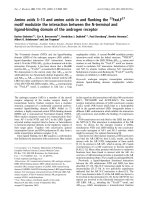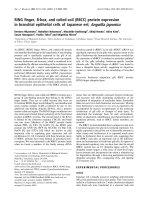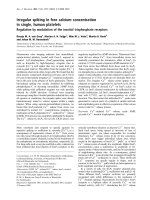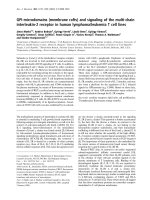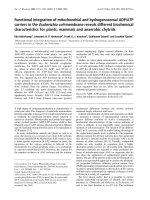Báo cáo y học: "Leukocyte trafficking in alveoli and airway passages Claire M Doerschuk" ppt
Bạn đang xem bản rút gọn của tài liệu. Xem và tải ngay bản đầy đủ của tài liệu tại đây (96.99 KB, 5 trang )
Review
Leukocyte trafficking in alveoli and airway passages
Claire M Doerschuk
Case Western Reserve University, Cleveland, Ohio, USA
Abstract
Many pulmonary diseases preferentially affect the large airways or the alveoli. Although the
mechanisms are often particular to each disease process, site-specific differences in
leukocyte trafficking and the regulation of inflammation also occur. Differences in the process
of margination, sequestration, adhesion, and migration occur that can be attributed to
differences in anatomy, hemodynamics, and the expression of proteins. The large airways are
nourished by the bronchial circulation, whereas the pulmonary circulation feeds the distal lung
parenchyma. The presence of different cell types in large airways from those in alveoli might
contribute to site-specific differences in the molecular regulation of the inflammatory process.
Keywords: adhesion molecules, margination, neutrophils, pulmonary inflammation, sequestration
Received: 12 July 2000
Revisions requested: 26 July 2000
Revisions received: 6 September 2000
Accepted: 6 September 2000
Published: 12 October 2000
Respir Res 2000, 1:136–140
The electronic version of this article can be found online at
/>© Current Science Ltd (Print ISSN 1465-9921; Online ISSN 1465-993X)
ICAM = intercellular cell-adhesion molecule; VCAM = vascular cell-adhesion molecule.
/>Introduction
Many of the diseases that affect the lungs involve inflam-
mation. Some diseases, such as asthma, bronchiectasis,
and infection with common environmental pathogens,
affect primarily the airways, whereas others affect the
distal bronchi, bronchioles, and alveoli, including bacterial
pneumonia and the acute respiratory distress syndrome.
Although many aspects of host defense and the inflamma-
tory response are common to these two sites, there are
differences in the mechanisms through which the inflam-
matory response occurs (Table 1). Many of these differ-
ences are related to the particular disease, for example the
immune response in asthma compared with innate immu-
nity in bacterial pneumonia, but some of the differences
are due to the differences in the circulations and in the
structural cell types that form the proximal airways com-
pared with the distal air spaces. For example, the airways
are fed largely by the bronchial circulation, whereas the
distal air spaces are supplied by the pulmonary circulation.
In addition, the airway epithelial cells seem to be important
in the regulation of the inflammatory response, whereas in
the more distal airways the alveolar macrophages and
dendritic cells seem important. The purpose of this review
is to compare the mechanisms underlying the response of
leukocytes to stimuli that affect primarily one of these two
lung regions.
Alveoli and distal airways
Leukocyte margination
The distal bronchioles and alveolar spaces are lined by
cuboidal epithelium and type I and II alveolar epithelium,
respectively, and are fed by the pulmonary circulation. The
/>commentary
review
reports primary research
pulmonary capillary bed comprises many short intercon-
necting segments, and a capillary pathway from an arteriole
to a venule contains approximately 40–100 capillary seg-
ments (reviewed in [1
•
,2]). In normal lungs, this bed con-
tains a large pool of marginated neutrophils, monocytes,
and lymphocytes, which are thought to be important in host
defense. The concentration of neutrophils in the capillary
blood measures 20–60 times the concentration in the
large systemic vessels. The transit time of neutrophils
through this capillary bed is longer, measuring on average
26–40 s, compared with the transit times of plasma or red
blood cells of 1.5–4.0 s [1
•
,2,3
••
,4
••
]. This longer transit
time is thought to be due to the time required for neu-
trophils to deform to an oblong shape to pass through the
40–60% pulmonary capillary segments that are narrower
than spherical neutrophils [5]. Measurements of neutrophil
shape showed that neutrophils in arterioles were nearly
spherical (shape factor of 1.1) whereas neutrophils in the
capillary bed had shape factors of 1.5 ± 0.3, suggesting
that most neutrophils must deform and elongate to travel
through the capillary bed [5,6]. These studies indicate that
the ability to deform is critical in the traffic of neutrophils
through normal pulmonary capillaries.
Leukocyte sequestration
During the acute inflammatory response within regions of
the distal lung tissue, neutrophils sequester within the capil-
lary bed. Studies examining the role of known adhesion mol-
ecules, including L-selectin, P-selectin, and CD11/CD18,
have demonstrated no role for these molecules in the initial
stages of sequestration, when neutrophils are stopping and
accumulating [7,8]. Once neutrophils have stopped, then
L-selectin and CD11/CD18 are required to keep the
sequestered neutrophils within the capillaries, at least in
response to some stimuli.
In many organs fed by the systemic vasculature, neutrophil
emigration occurs through the post-capillary venules.
Hemodynamic patterns and selectin-mediated rolling of
leukocytes are the major mechanisms through which
leukocytes sequester at these sites. However, because
rolling does not occur within the pulmonary capillary bed
and adhesion molecules seem not to be required [6–8],
we and others developed alternative hypotheses that
focused on the role of the mechanical properties of neu-
trophils and other leukocytes, particularly on their ability to
deform. Observations from many laboratories demon-
strated that inflammatory stimuli, particularly those which
bind to the seven transmembrane-spanning G protein
linked receptors, induce changes in the cytoskeleton of
neutrophils that result in a decreased ability to deform
[9
•
,10
•
,11]. These studies led to the hypothesis that stimu-
lus-induced increases in F-actin at the cell periphery led to
a decreased deformability, preventing neutrophils from
trafficking through the capillary bed and therefore increas-
ing their sequestration at sites of inflammation. The role of
these changes in vivo was suggested by observations
demonstrating that neutrophils sequestered in the pul-
monary capillaries of rabbits after the infusion of comple-
ment protein 5 fragments were rounder than neutrophils in
the capillaries of control rabbits [9
•
]. Although the hypoth-
esis that this increased stiffness and decreased ability to
deform mediates the initial sequestration of neutrophils
within the pulmonary capillary bed at sites of inflammation
has been difficult to prove directly, a considerable number
of circumstantial data have accumulated that support this
concept. Current studies are focused on understanding
the mechanisms through which inflammatory mediators
induce this rearrangement of the cytoskeleton.
The cytoskeletal changes that mediate the decreased
deformability seem transient, and adherence between the
neutrophils and the endothelial cells occurs within 5–30
min. The mechanical properties of these adherent and
crawling neutrophils become very complex. Yanai et al
[12] have demonstrated, with the use of optical tweezers,
that granules within the cytoplasm of the leading edge are
easier to oscillate than granules in the body or the trailing
region of neutrophils. Schmid-Schoenbein et al [13] have
suggested that pseudopods have more rigid viscoelastic
properties than the remainder of the leukocyte. A full
understanding of the biochemical and mechanical events
that occur during adhesion and crawling has not yet
emerged but is an important topic of investigation; the
events might be modulated in part through signaling by
ligated adhesion molecules. Neutrophil adhesion to
endothelial cells induces changes in both neutrophils and
endothelial cells that result in cytoskeletal and other intra-
cellular alterations that are probably required for the sub-
sequent steps in the response of neutrophils. For example,
when neutrophils bind to pulmonary microvascular
endothelial cells through intercellular cell-adhesion mole-
cule-1 (ICAM-1), ICAM-1-dependent intracellular signaling
responses are initiated [14]. This signaling response
Table 1
Differences between the alveoli and the airways
Bronchial compared with pulmonary circulation
Structure of vessels
Expression of adhesion molecules
Size and hemodynamic characteristics of the site of leukocyte
emigration
Structural differences in alveolar walls compared with bronchial walls
Cell types present
Anatomy and properties of the extracellular matrix
Response of structural cells at each site to inflammatory stimuli
Mediators released (cytokines, chemokines, and others)
Adhesion molecules expressed and used
Contribution of biomechanical events
Stimuli and disease processes affecting alveoli compared with airways
Respiratory Research Vol 1 No 3 Doerschuk
seems to require reactive oxygen species generated by
xanthine oxidase, and results in the remodeling of the
cytoskeleton through signaling pathways that are only now
being explained.
Leukocyte emigration
Following sequestration and initial adhesion, neutrophils
migrate along the capillary endothelium and into the inter-
stitium and alveoli. There are at least two pathways
through which this emigration occurs, one that uses the
leukocyte adhesion molecule CD11/CD18 and one that
does not. Which adhesion pathway is selected appears to
depend upon the stimulus (reviewed in [11]). Stimuli that
induce CD18-dependent emigration include Escherichia
coli, E. coli lipopolysaccharide, Pseudomonas aeruginosa,
IgG immune complexes, interleukin-1, and phorbol myris-
tate acetate. These stimuli seem to act by inducing the
translocation of nuclear factor-κB, resulting in the produc-
tion of inflammatory cytokines (including tumor necrosis
factor-α) and ICAM-1 on the pulmonary capillary endothe-
lial cells [11,15]. Stimuli that induce CD11/CD18-inde-
pendent neutrophil emigration include Streptococcus
pneumoniae, group B Streptococcus, Staphylococcus
aureus, hydrochloric acid, hyperoxia, and C5a. Although
the mechanisms through which the CD11/CD18-indepen-
dent mechanisms occur are less clearly described, neu-
trophil emigration occurs in the absence of enhanced
ICAM-1 expression on the pulmonary capillary endothe-
lium, and interferon-γ might be an important regulator of
this response. This pathway of neutrophil emigration
seems not to require known adhesion molecules, because
numerous studies blocking the function of these adhesion
molecules, either singly or in combination with blocking
antibodies, small molecules, or genetic depletion, have
demonstrated no defect in CD11/CD18-independent neu-
trophil migration. Current studies are focused on identify-
ing new genes by using differential display and gene
microarrays to compare transcripts made during CD18-
dependent and CD18-independent neutrophil emigration.
Neutrophils migrate into the alveolar spaces through a
well-defined pathway. The site of sequestration and migra-
tion is, as demonstrated by many investigators, the pul-
monary capillary bed rather than the post-capillary venules.
Neutrophils migrate between endothelial cells through
junctions located between the thick and the thin walls of
the capillary loops [16
•
]. This junctional site overlies dis-
continuities in the basal laminae and is the site of interac-
tions with interstitial fibroblasts within the alveolo-capillary
walls. The neutrophils then crawl into the interstitium,
where they are often in contact with the fibroblasts and
may be crawling along them [17
•
]. They then crawl to sites
where type I cells are adjacent to type II cells and prefer-
entially migrate between these two cell types to enter the
alveolar space. The process of migration is accompanied
by an increase in neutrophil volume, from approximately
128±9µm
3
to 266 ± 9 µm
3
[18]. Although this increase
in volume seems to be mediated through the sodium/
proton antiport, the function of the volume change is not
yet clear.
Airways and the bronchial circulation
Leukocyte trafficking in response to stimuli within the more
proximal bronchi occurs through the bronchial circulation.
This circulation consists of a capillary network in the
subepithelial region of the bronchi and a deeper system of
arterioles, capillaries, and venules. The diameter of these
capillaries has not been definitively determined under
physiological conditions, but they are likely to be wider
than pulmonary capillaries. The bronchial circulation dis-
plays many attributes of the systemic circulation in general
but has an unusual drainage system. More than 85% of
the systemic blood flow to the bronchial circulation returns
to the left ventricle, indicating the presence of anasto-
moses between the bronchial and the pulmonary circula-
tions [19
••
]. These anastomoses have been identified at
the pre-capillary, capillary, and post-capillary levels within
the pulmonary circulation.
It has been difficult to establish whether the bronchial
vessels contain a marginated pool of neutrophils or other
leukocytes. Baile et al [19
••
] demonstrated that the frac-
tion of neutrophils requiring a longer time than red blood
cells to pass through the bronchial circulation was lower
(50–60%) than the percentage in trafficking through the
pulmonary circulation (80%). This smaller margination
within the bronchial circulation might be due to differences
in the anatomy or the hydrodynamic dispersive forces
between these two vascular beds. This study might in fact
overestimate margination within the bronchial circulation,
because a portion of neutrophils could be delayed within
the pulmonary microvasculature while traversing the anas-
tomotic pathways. However, these studies do suggest
that margination within the bronchial circulation is less
than that observed in the pulmonary circulation.
Aspects of the inflammatory response in
airways compared with alveoli
The expression of adhesion molecules in normal lungs and
in response to inflammatory stimuli is different in these two
circulations. Normally, the pulmonary arterioles and
venules express P-selectin, ICAM-1, and vascular cell
adhesion molecule-1 (VCAM-1), but not E-selectin,
whereas the pulmonary capillaries express only low levels
of ICAM-1 and none of the other adhesion molecules
[15,20]. During the inflammatory response induced by a
variety of mediators (including bacteria), the expression of
E-selectin, P-selectin, and ICAM-1 is often increased on
pulmonary arterioles and venules. However, in the pul-
monary capillaries, where neutrophil migration primarily
occurs, only ICAM-1 expression is enhanced, and so far
only in response to stimuli that elicit CD18-independent
neutrophil migration. In contrast, in the bronchial microvas-
culature, P-selectin is expressed on nearly all vessels, and
E-selectin, VCAM-1, and ICAM-1 are expressed on many
[20]. Inflammatory stimuli induce the upregulation of these
molecules. For example, the bronchial microvasculature of
asthmatic lungs showed increased expression of
selectins, VCAM-1, and ICAM-1, in comparison with non-
asthmatic lungs [21,22].
Another difference in the inflammatory response within the
large airways from that in the distal lung parenchyma is in
the cells that regulate the response. In alveoli, alveolar
macrophages and dendritic cells seem to be important
modulators of the inflammatory response. The role of type I
epithelial cells seems small, although definitive studies
have not been performed. Type II cells might provide an
important source of mediators regulating the inflammatory
response, particularly in the production of surfactant pro-
teins that modulate the inflammatory response and in the
production of ICAM-1 on their surface, whose function is
still unclear [15,23]. In contrast, the many types of epithe-
lial cell lining the airways seem to regulate the response
within the bronchi, as well as the lymphocytes,
macrophages, fibroblasts, smooth-muscle cells, and other
cells within the interstitium, which is much wider than that
within the alveolo-capillary walls. Although some
chemokines and other mediators might be uniquely pro-
duced at only one site, many of the mediators produced in
the distal and proximal lung regions are similar. It remains
to be determined whether this difference in structural
components is important in the regulation of the inflamma-
tory response.
There are considerably fewer studies examining the func-
tion of adhesion molecules in bronchial inflammation.
During ozone-induced neutrophil emigration, CD11/
CD18, as well as members of the selectin family, seem
important in neutrophil emigration [24]. In patients with
asthma and animals with airways hyper-reactivity after sen-
sitization and challenge with ovalbumin, the major cell
types are lymphocytes and eosinophils. The adhesion mol-
ecules in this animal model that seem to be required for
the egress of these cells into the interstitium and air
spaces include VLA-4/VCAM-1, CD11/CD18-ICAM-1,
P-selectin, and E-selectin [22,25,26]. To my knowledge,
CD11/CD18 is crucial in the emigration of leukocytes
through the bronchial circulation, and no CD18-indepen-
dent pathways have been described.
Conclusion
There are striking differences in leukocyte trafficking
between the alveoli and the proximal airways of the lungs.
These differences appear to have multiple etiologies,
including differences in anatomy such as the diameter of
the vessels and the cell types that regulate the response,
differences in both the expression and the function of
adhesion molecules by endothelial cells, and differences
in the stimuli which induce the inflammatory response at
these sites. Although much has been learned about the
regulation of inflammation in the past decade, enormous
amounts remain to be uncovered, and our current knowl-
edge clearly touches only the tip of the complexities that
underlie host defense and inflammation in the lungs.
Acknowledgements
I thank James C. Hogg, Joseph P. Mizgerd, and Qin Wang for numerous
invaluable discussions over many years, and Virginia Ehrbar for help with
preparing the manuscript. I apologize to the many scientists whose work I
was unable to cite because of limitations on citation numbers. This work was
supported by NIH HL 48160, HL 52466 and HL 33009, and a Clinical Sci-
entist Award in Translational Research from the Burroughs Wellcome Fund.
References
Articles of particular interest have been highlighted as:
•
of special interest
••
of outstanding interest
1. Hogg JC: Neutrophil kinetics and lung injury. Physiol Rev 1987,
•
67:1249–1295.
This paper provides an outstanding review of the pulmonary circulation and
neutrophil kinetics.
2. Hogg JC, Doerschuk CM: Leukocyte traffic through the lung. Annu
Rev Physiol 1995, 57:97–114.
3. Lien DC, Wagner WW Jr, Capen L, Haslett C, Hanson WL, Hofmeis-
••
ter SE, Henson PM, Worthen GS: Physiological neutrophil seques-
tration in the lung: visual evidence for localization in capillaries. J
Appl Physiol 1987, 62:1236–1243.
These authors were the first to directly measure the transit times of neu-
trophils through the capillary bed and to describe the manner in which they
traversed the bed.
4. Presson, RGJ, Graham JA, Hanger CC, Godbey PS, Gebb SA, Sidner
••
RA, Glenny RW, Wagner WW Jr: Distribution of pulmonary capil-
lary red blood cell transit times. J Appl Physiol 1995, 79:382–388.
This article describes the frequency distribution of red blood cell transit
times through the pulmonary capillaries by using direct visualization and the
application of a refined deconvolution technique.
5. Doerschuk CM, Beyers N, Coxson HO, Wiggs B, Hogg JC: Compari-
son of neutrophil and capillary diameters and their relation to
neutrophil sequestration in the lung. Appl Physiol 1993, 74:3040–
3045.
6. Gebb SA, Graham JA, Hanger CC, Godbey PS, Capen RL, Doer-
schuk CM, Wagner WW Jr: Sites of leukocyte sequestration in the
pulmonary microcirculation. J Appl Physiol 1995, 79:493–497.
7. Doerschuk CM: The role of CD18-mediated adhesion in neutrophil
sequestration induced by infusion of activated plasma in rabbits.
Am J Respir Cell Mol Biol 1992, 7:140–148.
8. Kubo H, Doyle NA, Graham L, Bhagwan SD, Quinlan WM, Doerschuk
CM: L- and P-selectin and CD11/CD18 in intracapillary neutrophil
sequestration in rabbit lungs. Am J Respir Crit Care Med 1999,
159:267–274.
9. Motosugi H, Graham L, Noblitt TW, Doyle NA, Quinlan WM, Li Y,
•
Doerschuk CM: Changes in neutrophil actin and shape during
sequestration induced by complement fragments in rabbits. Am J
Pathol 1996, 149:963–973.
This paper provides evidence in vivo supporting the hypothesis that
decreased deformability is the basis for pulmonary capillary sequestration of
neutrophils induced by inflammatory mediators.
10. Worthen GS, Schwab B III, Elson EL, Downey GP: Mechanics of
•
stimulated neutrophils: cell stiffening induces retention in capillar-
ies. Science 1989, 245:183–186.
These authors provide the first evidence in vivo that inhibiting the decrease
in deformability of neutrophils induced by fMet-Leu-Phe prevents their
sequestration in the lungs.
/>commentary
review
reports primary research
Respiratory Research Vol 1 No 3 Doerschuk
11. Doerschuk CM, Mizgerd JP, Kubo H, Qin L, Kumasaka T: Adhesion
molecules and cellular biomechanical changes in acute lung
injury. Giles F. Filley Lecture. Chest 1999, 116:37–43S.
12. Yanai M, Butler JP, Suzuki T, Kanda A, Kurachi M, Tashiro H, Sasaki H:
Intracellular elasticity and viscosity in the body, leading, and trail-
ing regions of locomoting neutrophils. Am J Physiol 1999, 277:
C432–C440.
13. Schmid-Schonbein GW, Skalak R, Sung KLP, Chien S: Human
leukocytes in the active state. In White Blood Cells. Morphology
and Rheology as Related to Function. Edited by Bagge U, Born GVR,
Gaehtgens P. The Hague: Martinus Nijhoff; 1982:21–31.
14. Wang Q, Doerschuk CM: Neutrophil-induced changes in the bio-
mechanical properties of endothelial cells: the roles of ICAM-1
and reactive oxygen species. J Immunol 2000, 164:6487–6494.
15. Burns AB, Doerschuk CM: Quantitation of L-selectin and CD18
expression on rabbit neutrophils during CD18-independent and
CD18-dependent emigration in the lung. J Immunol 1994, 153:
3177–3188.
16. Walker DC, Behzad AR, Chu F: Neutrophil migration through pre-
•
existing holes in the basal laminae of alveolar capillaries and
epithelium during streptococcal pneumonia. Microvasc Res 1995,
50:397–416.
This paper, in combination with reference 17, provides the first description
of the pathway that neutrophils take in migrating from the capillaries to the
alveolar space.
17. Behzad AR, Chu F, Walker DC: Fibroblasts are in a position to
•
provide directional information to migrating neutrophils during
pneumonia in rabbit lungs. Microvasc Res 1996, 51:303–316.
This paper, in combination with reference 16, provides the first description
of the pathway that neutrophils take in migrating from the capillaries to the
alveolar space.
18. Worthen GS, Henson PM, Rosengren S, Downey GP, Hyde DM:
Neutrophils increase volume during migration in vivo and in vitro.
Am J Respir Cell Mol Biol 1994, 10:1–7.
19. Baile EM, Paré PD, Ernest D, Dodek PM: Distribution of blood flow
••
and neutrophil kinetics in bronchial vasculature of sheep. J Appl
Physiol 1997, 82:1466–1471.
These authors of this paper compare the transit of neutrophils through the
bronchial and the pulmonary circulations, as well as documenting that the
drainage of the bronchial circulation occurs primarily into the left ventricle.
20. Feuerhake F, Füchsl G, Bals R, Welsch U: Expression of inducible
cell adhesion molecules in the normal human lung: immunohisto-
chemical study of their distribution in pulmonary blood vessels.
Histochem Cell Biol 1998, 110:387–394.
21. Hirata N, Kohrogi H, Iwagoe H, Goto E, Hamato J, Fujii K, Yamaguchi
T, Kawano O, Ando M: Allergen exposure induces the expression
of endothelial adhesion molecules in passively sensitized human
bronchus: time course and the role of cytokines. Am J Respir Cell
Mol Biol 1998, 18:12–20.
22. Schleimer RP, Bochner BS: The role of adhesion molecules in
allergic inflammation and their suitability as targets of antiallergic
therapy. Clin Exp Allergy 1998, 28 Suppl 3:15–23.
23. Wright JR: Immunomodulatory functions of surfactant. Physiol Rev
1997, 77:931–962.
24. Hyde DM, Miller LA, McDonald RJ, Stovall MY, Wong V, Pinkerton KE,
Wegner CD, Rothlein R, Plopper CG: Neutrophils enhance clear-
ance of necrotic epithelial cells in ozone-induced lung injury in
rhesus monkeys. Am J Physiol 1999, 277:L1190–L1198.
25. Wolyniec WW, De Sanctis GT, Nabozny G, Torcellini C, Haynes N,
Joetham A, Gelfand EW, Drazen JM, Noonan TC: Reduction of
antigen-induced airway hyperreactivity and eosinophilia in ICAM-
1-deficient mice. Am J Respir Cell Mol Biol 1998, 18:777–785.
26. DeSanctis GT, Wolyniec WW, Green FHY, Qin S, Jiao A, Finn P,
Noonan T, Joetham AA, Gelfand E, Doerschuk CM, Drazen JM:
Reduction of allergic airway responses in P-selectin deficient
mice. J Appl Physiol 1997, 83:681–687.
Author’s affiliation: Department of Pediatrics, Case Western Reserve
University, Cleveland, Ohio, USA
Correspondence: Claire M. Doerschuk, MD, Rainbow Babies and
Children’s Hospital, Room 787, 11100 Euclid Avenue, Cleveland,
OH 44106, USA. Tel: +1 216 844 7353; fax: +1 216 844 7642;
e-mail:




